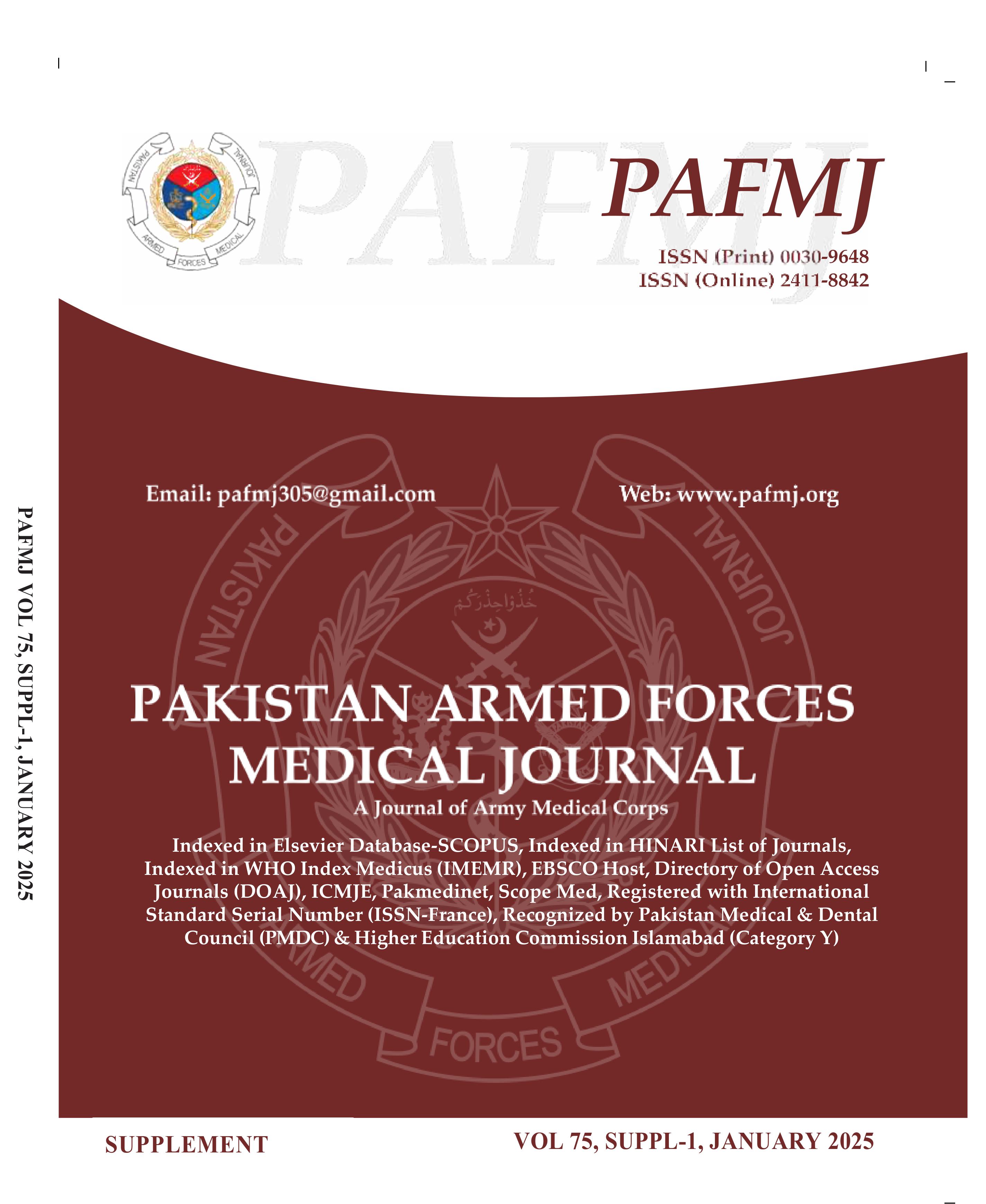Various Clinicopathological Presentaions of Cholestasis in Infants Presenting to Tertiary Care Hospital
Presentation of Cholestasis in Infants
DOI:
https://doi.org/10.51253/pafmj.v75iSUPPL-1.4776Keywords:
Idiopathic neonatal hepatitis, Jaundice, neonatal cholestasis.Abstract
Objective: To determine various Clinico-pathological presentations of cholestasis in infants presenting to Tertiary Care Hospital.
Study Design: Cross-sectional study.
Place and Duration of Study: Department of Pediatric Medicine, Pakistan Navy Station Shifa Hospital, Karachi Pakistan, from Jan 2022 to Jun 2022.
Methodology: A total of 95 infants with persistent jaundice aged 2 weeks to 12 months of either gender were included. Jaundice case secondary to hemolysis and serious illness were excluded. After taking informed written consent from all children’s parents, clinical presentations i.e. Jaundice, clay-coloured stools, pale stools, hepatomegaly and splenomegaly of cholestasis were noted. Essential labs and radiological investigations were also done at the clinico-pathological Laboratory of our institute.
Results: Mean age of the infants was 4.85±2.48 months. Out of the 95 infants, 61(64.21%) were male and 34(35.79%) were females with a male to female ratio of 1.8:1. Jaundice was present in 95(100%), hepatomegaly 78(82.11%), Acholic stools 74(77.89%), and splenomegaly in 66(69.47%) patients. The common causes of cholestasis were idiopathic neonatal hepatitis in 54(56.84%), biliary atresia in 25(26.32%) and Progressive Familial Intrahepatic Cholestasis in 26(27.37%) patients.
Conclusion: This study has shown that the common clinical feature of cholestasis in infants is jaundice followed by hepatomegaly, acholic stools and splenomegaly. The common cause was idiopathic neonatal hepatitis followed by biliary atresia and progressive familial intrahepatic cholestasis.
Downloads
References
Dantas AV, Farias LJ, de Paula SJ, Moreira RP, da Silva VM, de Oliveira Lopes MV, et al. Nursing diagnosis of neonatal jaundice: study of clinical indicators. Journal of pediatric nursing 2018 Mar 1; 39:e6-10.
https://doi.org/10.1016/j.pedn.2017.12.001
Saad AA, Altegani Hb, ali ra. Neonatal jaundice; prevalenc and its associated risk factor as seen in omdurman maternity hospital (Doctoral dissertation, Napata College).
Rana N, Ranneberg LJ, Målqvist M, Kc A, Andersson O. Delayed cord clamping was not associated with an increased risk of hyperbilirubinaemia on the day of birth or jaundice in the first 4 weeks. Acta Paediatrica 2020; 109(1): 71-77.
Goudarzvand L, Dabirian A, Nourian M, Jafarimanesh H, Ranjbaran M. Comparison of conventional phototherapy and phototherapy along with Kangaroo mother care on cutaneous bilirubin of neonates with physiological jaundice. The Journal of Maternal-Fetal & Neonatal Medicine 2019 ; 32(8): 1280-1284.
https://doi.org/10.1080/14767058.2017.1404567
Misra S, Majumdar K, Sakhuja P, Jain P, Singh L, Kumar P, et al. Differentiating Biliary Atresia From Idiopathic Neonatal Hepatitis: A Novel Keratin 7 Based Mathematical Approach on Liver Biopsies. Pediatric and Developmental Pathology 2021; 24(2): 103-115.
https://doi.org/ 10.1177/1093526620983730
Mells G, Alexander G. Liver Function in Health and Disease: Clinical Application of Liver Tests. Sherlock's Diseases of the Liver and Biliary System 2018: 20-38.
Mahmud S, Gulshan J, Mashud Parvez FT, Ahmed SS. Singapore Journal of Gastroenterology.
Hilscher MB, Kamath PS, Eaton JE. Cholestatic liver diseases: a primer for generalists and subspecialists. In Mayo Clinic Proc 2020; 95(10): 2263-2279.
https://doi.org/10.1016/j.mayocp.2020.01.015
Shahraki T, Miri-Aliabad G, Shahraki M. Frequency of Different Causes of Infant Cholestasis in a Tertiary Referral Center in South-East Iran. Iranian Journal of Pediatrics. 2018 Oct 31; 28(5).
Sihaklang B, Piriyanon P, Intarakhao S. Etiology and Clinical presentation of cholestatic jaundice during infancy period in Thammasat University Hospital. TMJ. 2020 Jul 8; 20(2):137-45.
Bilal H, Irshad M, Shahzadi N, Hashmi A, Ullah H. Neonatal Cholestasis: The Changing Etiological Spectrum in Pakistani Children. Cureus 2022; 14(6): e25882.
https://doi.org/10.7759/cureus.25882
Benzamin M, Khadga M, Begum F, Rukunuzzaman M, Mazumder MW, Lamia KN, Islam MS, Rahman AR, Karim AB. Etiologies of neonatal cholestasis at a tertiary hospital in Bangladesh. Paediatrica Indonesiana 2020; 60(2): 67-71.
Quelhas P, Jacinto J, Cerski C, Oliveira R, Oliveira J, Carvalho E, et al. Protocols of Investigation of Neonatal Cholestasis—A Critical Appraisal. Healthcare [Internet] 2022; 10(10): 2012. Available from:
https://www.mdpi.com/2227-9032/10/10/2012
Vij, M., & Rela, M. (2020). Biliary Atresia: pathology, Etiology and Pathogenesis. Future Science OA, 6(5).
https://doi.org/10.2144/fsoa-2019-0153
Parvez M, Arjuman F, Arshad–Ul–Azim M, Mahmud S, Ahmed SS. Histopathological Evaluation of Childhood Liver Disease: An Experience in a Tertiary Centre of Bangladesh [Internet]. www.bapath.org. Journal of Histopathology and Cytopathology; 2021 [cited 2024 Nov 4]. Available from: https://www.bapath.org/jhc-2021-jan-v5-n1/
Akhtar W, Tahir AM, Balooch S, Aslam S, Sohail A, Khan S, et al. Clinical presentations and histopathological types of chronic liver disease in paediatric population. Pak J Pathol 2021; 32(1): 29-32
Mehta S, Kumar K, Bhardwaj R, Malhotra S, Goyal N, Sibal A. Progressive Familial Intrahepatic Cholestasis: A Study in Children from a Liver Transplant Center in India. Journal of Clinical and Experimental Hepatology [Internet] 2022; 12(2):
–60. Available from:
https://www.sciencedirect.com/science/article/pii/S0973688321001481
Ali M, Cheema HA, Alvi MA, Waheed N,. I, Anjum MN. Phenotypic And Genotypic Characteristics of Progressive Familial Intrahepatic Cholestasis Type 3 In Pediatric Population in Pakistan. Khyber Med Univ J [Internet] 2022 Mar. 31 [cited 2024 Nov. 4]; 14(1): 11-15. Available from:
Downloads
Published
Issue
Section
License
Copyright (c) 2025 Javaid Iqbal, Shabbir Hussain, Sana Khan, Hafiz Abdul Quddus, Hafiz Muhammad Murtaza, Muhammad Nadeem Chohan

This work is licensed under a Creative Commons Attribution-NonCommercial 4.0 International License.















